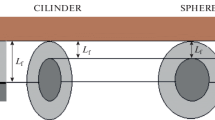Abstract
Batch electrochemical reactor models for parallel reaction sequences are developed for cells operating galvanostatically. Independent and dependent parallel reactions and a parallel-series reaction scheme are considered and emphasis is placed on the development of analytical expressions to predict reactor behaviour. Electro-organic synthesis reactions such as the production of betaalanine and glyoxylic acid are considered as examples. Experimental data for the electro-oxidation of aqueous oxalic acid and glyoxylic acid solutions are shown to be in reasonable agreement with the reaction analysis.
Similar content being viewed by others
Abbreviations
- a :
-
Parameter defined in Equation 21
- C sj :
-
Surface concentration of species j
- C j :
-
Bulk concentration of species j
- C jo :
-
Initial concentration of species j
- C Bmax :
-
Maximum concentration of species B
- CE :
-
Current efficiency
- E :
-
Electrode potential
- F :
-
Faraday constant
- i p :
-
Partial current density of step p of reaction scheme
- i t :
-
Total current density
- k fp :
-
Forward electrochemical rate constant of step p
- k Lj :
-
Mass transfer coefficient for species j
- K L :
-
Dimensionless mass transfer parameter
- n p :
-
Number of electrons in step p of reaction scheme
- S :
-
Electrode area
- t :
-
Reaction time
- V :
-
Batch reactor volume
- β p :
-
Constant describing potential dependency of reaction rate constant of reaction step p
- Y 1,Y 2,Y 3 :
-
Effective overall resistance factors
- τg :
-
Dimensionless reaction time for galvanostatic operation
- τp :
-
Dimensionless reaction time for potentiostatic operation
References
M. Fleischmann and R. E. W. Jansson,J. Appl. Electrochem. 9 (1979) 427.
O. Levenspiel ‘Chemical Reaction Engineering’ 2nd Ed, J. Wiley, New York (1972).
F. Goodridge and A. R. Wright in ‘Comprehensive Treatise of Electrochemistry’ Vol. 6 (edited by E. Yeager, J. O. M. Bockris, B. E. Conway and S. Sarangapani) Plenum Press, New York (1983).
G. P. Sakellaropoulos and G. A. Francis,J. Electrochem. Soc. 126 (1979) 1928.
G. P. Sakellaropoulos,AIChEJ 25 (1979) 781.
G. P. Sakellaropoulos and G. A. Francis,J. Chem. Tech. Biotechnol. 30 (1980) 102.
K. Scott,Electrochim. Acta 30 (1985) 235.
Idem, ibid. 30 (1985) 245.
V. Krishnan, K. Ragupathy and H. V. K. Udupa,J. Appl. Electrochem. 8 (1978) 169.
K. Scott, submitted toChem. Eng. Res. Design.
K. Scott, PhD Thesis University of Newcatle-upon-Tyne, UK (1977).
D. J. Pickett and K. S. Yap,J. Appl. Electrochem. 4 (1974) 17.
F. Goodridge, K. Lister, R. E. Plimley and K. Scott,J. Appl. Electrochem. 10 (1980) 55.
Author information
Authors and Affiliations
Rights and permissions
About this article
Cite this article
Scott, K. Reactor engineering models of complex electrochemical reaction schemes. III. Galvanostatic operation of parallel reactions in batch reactors. J Appl Electrochem 15, 837–858 (1985). https://doi.org/10.1007/BF00614360
Received:
Revised:
Issue Date:
DOI: https://doi.org/10.1007/BF00614360



